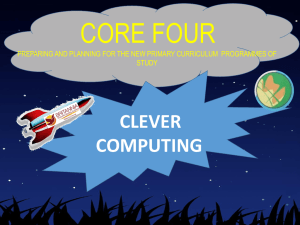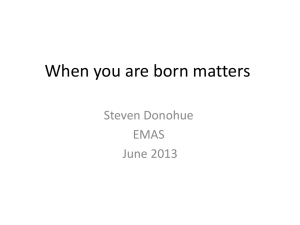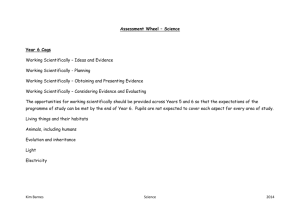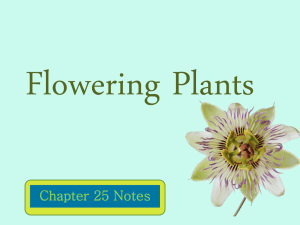Training Day 25/11/13
advertisement
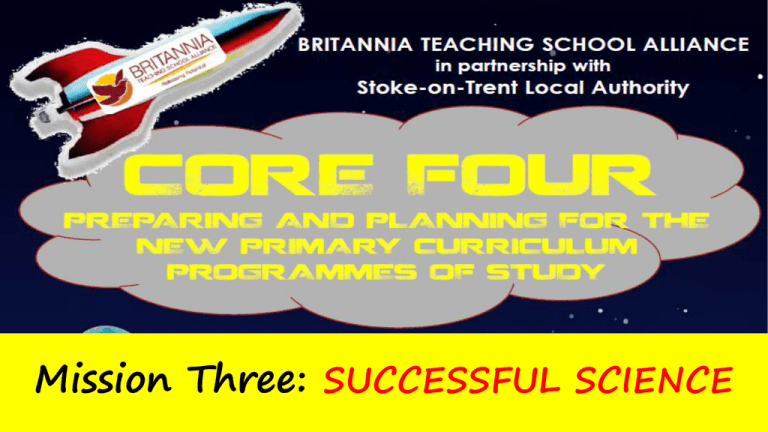
Mission Three: SUCCESSFUL SCIENCE Welcome & Introduction Overview for the day… 9:15 Session 1: Overview of the new curriculum 10:30 BREAK 10:45 Session 2: Planning for the new curriculum 12:00 LUNCH Reps from a selection of publishers 12:45 Session 3: Working scientifically part 1 1:30 BREAK? 1:45 Session 4: Working scientifically part 2 3:00 Feedback and where next? Session 1: Overview of the new curriculum Aim… To enable you to develop your understanding and knowledge of the new science primary curriculum and its implications for you and your school. Aims of the new curriculum… The national curriculum for science aims to ensure that all pupils: develop scientific knowledge and conceptual understanding through the specific disciplines of biology, chemistry and physics develop understanding of the nature, processes and methods of science through different types of science enquiries that help them to answer scientific questions about the world around them are equipped with the scientific knowledge required to understand the uses and implications of science, today and for the future. http://www.britanniateachingschool.co.uk/index.php?page=resources Year group Core objectives you MUST teach Guidance and Context for how you COULD implement the statutory requirements Knowledge aspect… Working scientifically aspect… What’s in and what’s out? Current Year 1 1A Ourselves 1B Growing plants 1C Sorting and using materials OUT 1D Light and dark 1E Pushes and pulls 1F Sound and hearing 2014 Curriculum Animals including humans Plants Everyday materials IN Seasonal changes Current Year 2 2A Health and growth 2B Plants, animals and the local environment 2C Variation 2D Grouping and changing materials OUT 2E Forces and movement 2F Using electricity 2014 Curriculum Animals including humans Living things and their habitats Plants Uses of everyday materials Current Year 3 3A Teeth and eating 3B Helping plants grow well 3D Rocks and soils 3E Magnets and springs 3F Light and shadows OUT 3C Characteristics of materials 2014 Curriculum Animals including humans Plants Rocks Forces and magnets Light Year 4 Current 2014 Curriculum 4A Moving and growing 4B Habitats 4D Liquids, solids and gases 4F Circuits and conductors Animals including humans Living things and their habitats States of matter Electricity OUT IN 4C Keeping warm 4E Friction Sound Year 5 Current 2014 Curriculum 5A Keeping healthy 5B Lifecycles 5D Changing state 5E Earth, Sun and Moon Animals including humans Living things and their habitats Properties and changes of materials Earth and space OUT IN 5C Gases around us 5F Changing sounds Forces Current Year 6 6A Interdependence and adaptation 6F How we see things 6G Changing circuits OUT 6B Micro-organisms 6C More about dissolving 6D Reversible and irreversible changes 6E Forces in action 2014 Curriculum Living things and their habitats Light Electricity IN Animals including humans Evolution and inheritance How have the objectives changed? SC2 LIFE PROCESSES AND LIVING THINGS KS1 CURRENT Green plants 3. Pupils should be taught: a. to recognise that plants need light and water to grow b. to recognise and name the leaf, flower, stem and root of flowering plants c. that seeds grow into flowering plants 5. Pupils should be taught to: a. find out about the different kinds of plants and animals in the local environment b. identify similarities and differences between local environments and ways in which these affect animals and plants that are found there c. care for the environment KS2 CURRENT Green plants 3. Pupils should be taught: Growth and nutrition a. the effect of light, air, water and temperature on plant growth b. the role of the leaf in producing new material for growth c. that the root anchors the plant, and that water and minerals are taken in through the root and transported through the stem to other parts of the plant Reproduction d. about the parts of the flower [for example, stigma, stamen, petal, sepal] and their role in the life cycle of flowering plants, including pollination, seed formation, seed dispersal and germination Variation and classification 4. Pupils should be taught: a. to make and use keys b. how locally occurring animals and plants can be identified and assigned to groups c. that the variety of plants and animals makes it important to identify them and assign them to groups Living things in their environment 5. Pupils should be taught: a. about ways in which living things and the environment need protection Adaptation b. about the different plants and animals found in different habitats c. how animals and plants in two different habitats are suited to their environment 2014 CURRICULUM KS1 & KS2 YEAR 1 Identify and name a variety of common wild and garden plants, including deciduous and evergreen trees. Describe the basic structure of a variety of common flowering plants, including trees. YEAR 2 Observe and describe how seeds and bulbs grow into mature plants. Find out and describe how plants need water, light and a suitable temperature to grow and stay healthy. YEAR 3 Identify and describe the functions of different parts of flowering plants: roots, stem/trunk, leaves and flowers. Explore the requirements of plants for life and growth (air, light, water, nutrients from soil, and room to grow) and how they vary from plant to plant Investigate the way in which water is transported within plants. Explore the part that flowers play in the life cycle of flowering plants, including pollination, seed formation and seed dispersal. YEAR 5 Describe the life process of reproduction in some plants( and animals). SC3 MATERIALS AND THEIR PROPERTIES KS1 CURRENT KS2 CURRENT Changing materials 2. Pupils should be taught to: a. find out how the shapes of objects made from some materials can be changed by some processes, including squashing, bending, twisting and stretching b. explore and describe the way some everyday materials [for example, water, chocolate, bread, clay] change when they are heated or cooled Changing materials 2. Pupils should be taught: a. to describe changes that occur when materials are mixed [for example, adding salt to water] b. to describe changes that occur when materials [for example, water, clay, dough] are heated or cooled c. that temperature is a measure of how hot or cold things are d. about reversible changes, including dissolving, melting, boiling, condensing, freezing and evaporating e. the part played by evaporation and condensation in the water cycle f. that non-reversible changes [for example, vinegar reacting with bicarbonate of soda, plaster of Paris with water] result in the formation of new materials that may be useful g. that burning materials [for example, wood, wax, natural gas] results in the formation of new materials and that this change is not usually reversible 2014 CURRICULUM KS1 & KS2 Year 2 Find out how the shapes of solid objects made from some materials can be changed by squashing, bending, twisting and stretching. (NO HEATING / COOLING) Year 4 Observe that some materials change state when they are heated or cooled, and measure or research the temperature at which this happens in degrees Celsius (°C) (NO CHEMICAL CHANGES) Year 5 Demonstrate that dissolving, mixing and changes of state are reversible changes. Explain that some changes result in the formation of new materials, and that this kind of change is not usually reversible, including changes associated with burning and the action of acid on bicarbonate of soda. Know that some materials will dissolve in liquid to form a solution, and describe how to recover a substance from a solution. SC4 PHYSICAL PROCESSES KS1 CURRENT KS2 CURRENT Electricity 1. Pupils should be taught: a. about everyday appliances that use electricity b. about simple series circuits involving batteries, wires, bulbs and other components [for example, buzzers, motors] c. how a switch can be used to break a circuit Electricity 1. Pupils should be taught: Simple circuits a. to construct circuits, incorporating a battery or power supply and a range of switches, to make electrical devices work [for example, buzzers, motors] b. how changing the number or type of components [for example, batteries, bulbs, wires] in a series circuit can make bulbs brighter or dimmer c. how to represent series circuits by drawings and conventional symbols, and how to construct series circuits on the basis of drawings and diagrams using conventional symbols 2014 CURRICULUM KS1 & KS2 Year 4 Identify common appliances that run on electricity. Construct a simple series electrical circuit, identifying and naming its basic parts, including cells, wires, bulbs, switches and buzzers. Identify whether or not a lamp will light in a simple series circuit, based on whether or not the lamp is part of a complete loop with a battery. Recognise that a switch opens and closes a circuit and associate this with whether or not a lamp lights in a simple series circuit. Recognise some common conductors and insulators, and associate metals with being good conductors. Year 6 Associate the brightness of a lamp or the volume of a buzzer with the number and voltage of cells used in the circuit. cCompare and give reasons for variations in how components function, including the brightness of bulbs, the loudness of buzzers and the on/off position of switches. Use recognised symbols when representing a simple circuit in a diagram. Curriculum Overview… 2014 Curriculum Overview Working Scientifically What do you think of the changes so far? What’s missing? Our ideas… PHYSICS? - Electricity - Forces - Light Session 2: Planning in the new curriculum How will the new curriculum affect planning? Example lesson plan from a medium plan for Year 4 States of Matter Over to you… Working as a small group (3-4), plan a skeleton medium term plan for the unit and year group you have chosen. OUR GOAL… To create a scheme of work for the entire primary science curriculum! Feedback? Publishers… - Millgate House - Harper Collins Session 3: Working Scientifically Part 1 Working Scientifically Pick 5 of the Vocabulary Bingo! following words… Investigation Question Measurement What makes a good science lesson? Some ideas… -Experience Science outside the classroom -Cross curricular links -Children use Science to relate to the real world -Science vocabulary is used Teachers facilitate learning for children -Children are enthusiastic and engaged -Teachers have good subject knowledge -Asking questions -Independent learning -Builds on prior learning -Explains relationships -Think critically – Evaluate. (how reliable are the results…what is the source of the information?) -Challenge Science starters… Ginn 6 minute starter books How could you use the starters? Other starter ideas… • BBC Broadband class clips • Concept Cartoons (Millgate house publishers) • Tig Tag • Science Kids Session 4: Working Scientifically Part 2 Paper Spinners Investigation… Choose a role and then carry out your investigation… - Manager - Time Manager - Measurer x 2 (accuracy!) - Recorder - Resource Manager What skills did you use? Next time… Any Questions? Julie- jriddell@sgfl.org.uk Luci- lkendrick@belgrave.stoke.sch.uk
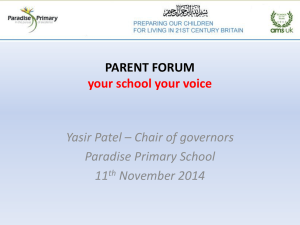
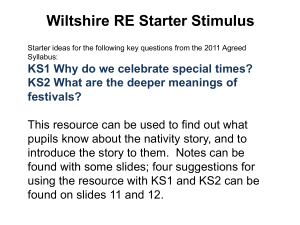
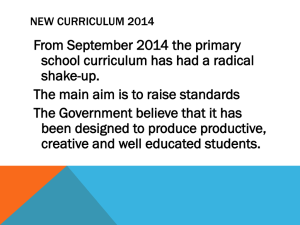

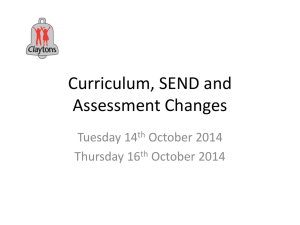
![afl_mat[1]](http://s2.studylib.net/store/data/005387843_1-8371eaaba182de7da429cb4369cd28fc-300x300.png)
